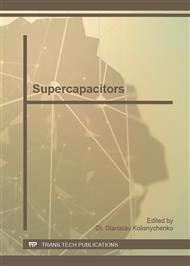[1]
W. Haigang, R. Dougal: Dynamic Multi–Resolution Modeling of Power Super Capacitor, Power Symposium, 2005, Proceedings of the 3-7th Annual North American 23-25 Oct, 2005, pp.241-246.
DOI: 10.1109/naps.2005.1560532
Google Scholar
[2]
Cesiwid Maxcap Double Layer Capacitors Product Informationand Application Data.
Google Scholar
[3]
Huiyan Zhang, Zhiping Qi: Design of super capacitors tank, Power Source Technology, vol. 130(4), 2006, pp.322-325.
Google Scholar
[4]
S-M. Kim and S-K. Sul: Control of the Rubber Tyred Gantry Crane With Energy Storage Based on Super Capacitor Bank, IEEE Transactions on Power Electronics, Vol. 21, No. 5, pp.1420-1427, Sept. (2006).
DOI: 10.1109/tpel.2006.880260
Google Scholar
[5]
T. Kinjo, T. Senjyu, K. Uezato, H. Fujita, Output- l eveling of renewable energy bypower electric double-layer capacitor applied for energy storage system, IEEE Trans. Energy Conv. 21 (1) (2006) 221–227.
DOI: 10.1109/tec.2005.853752
Google Scholar
[6]
R. Kötz, M. Carlen: Principles and applications of electrochemical capacitors, Electrochim. Acta 45 (2000), pp.2483-2498.
DOI: 10.1016/s0013-4686(00)00354-6
Google Scholar
[7]
H. Liu, C. Mao, J. Lu, and D. Wang: Electronic power transformer with supercapacitors storage energy system, Electric Power Systems Research, 79, 2009, pp.1200-1208.
DOI: 10.1016/j.epsr.2009.02.012
Google Scholar
[8]
C. Lungoci, E. Helerea, and I, Olteanu: Batteries and supercapacitors for power systems used in transport, Proceeding of SIELMEN 2009, Annals of Craiova University, Engineering Series, Craiova, (2009).
Google Scholar
[9]
Haerri, V.V.; Martinovic, D: Supercapacitor module SAM for hybrid busses: an advanced energy storage specification based on experiences with the TOHYCO-Rider Bus Project, IECON 2007, The 33rd Annual Conference Kluwer Accademic, IEEE Volume, 5-8 Nov. 2007, pp.268-273.
DOI: 10.1109/iecon.2007.4460395
Google Scholar
[10]
T. Mishima and E. Hiraki: ZVS-SR Bidirectional DC-DC Converter for Supercapacitor Applied Automotive Electric Energy Storage Systems, Vehicle Power and Propulsion IEEE, pp.2487-2493, (2005).
DOI: 10.1109/vppc.2005.1554639
Google Scholar
[11]
S. Kim, S. Sul, Control of rubber tyredGantryCrane with energy storage based on supercapacitor bank, IEEE Trans. Energy Conv. 21 (6) (2006) 1420–1427.
DOI: 10.1109/tpel.2006.880260
Google Scholar
[12]
Jijie Shi, Ying Zhong, Xinghua Li: Research on High-Precision Survey of Supercapacitor Capacity, ISCID 2011, Fourth International Symposium, IEEE Volume, 28-30 Oct. 2011, pp.219-222.
DOI: 10.1109/iscid.2011.156
Google Scholar



